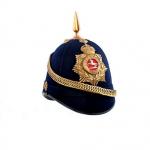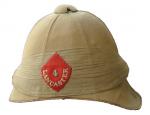-
Posts
1,761 -
Joined
-
Last visited
-
Days Won
3
Content Type
Profiles
Forums
Blogs
Gallery
Events
Store
Everything posted by Stuart Bates
-
The popular view is that the British Police Helmet was derived from the Prussian pickelhaube but what proof is there for this view? I have read that the pickelhaube was "copied" from the Russians and one only has to look at illustrations from the Crimean War 1854-1856 to see the Russian soldiery wearing a spiked helmet. The British Army in India were wearing a helmet, which was later called the Colonial pattern, from the early 1850s and this is much closer to the police helmet than the pickelhaube. Early types of this helmet featured a ventilation comb to the top which mirrors one of the variants of the police helmet and was called the air-pipe, air-chamber or air-tube helmet with the major manufacturer being Ellwoods. In 1870 the Colonial pattern, as pictured below, was mandated for British forces serving overseas. There is a lovely photo of an officer of the 21st Foot in full campaign dress in the D P & G reprint of the 1874 DRs and he is wearing a Colonial pattern helmet complete with spike. Thoughts? Stuart
-

ANOTHER BI-CORNE HAT
Stuart Bates replied to Mervyn Mitton's topic in Great Britain: Militaria: Badges, Uniforms & Equipment
Their uniform is described in Jones' catalogue of 1886 and has changed dramatically to what looks very much like No.1 Dress Blues but with the wonderful embroidery. I wonder when this occurred. Stuart -

ANOTHER BI-CORNE HAT
Stuart Bates replied to Mervyn Mitton's topic in Great Britain: Militaria: Badges, Uniforms & Equipment
Mervyn, I don't much care for bi-cornes even though I have a couple but this one is magnificent. Is the plume of white feathers only or are there red ones beneath? The embroidery is a work of art. English and Welsh Lords Lieutenant had oak leaves and acorns, Scottish had the thistle (the curse of Australian farmers) and the Irish of course had the shamrock. Stuart -
Chris, I tried glass heads in the beginning but found them to be more often than not too large for the headgear. I switched to perspex tubes 210mm tall, depending on the particular item, covered with black cotton socks and topped with a white linen/cotton cushion. The cushion alleviates the pressure of the tube distorting the headgear and I can size them to suit each item. I attach a photo of how it looks. This is an old photo and I initially used black women's stockings (no jokes please x 2) but they were not heavy enough. Stuart
-
Brett, I found and have ordered The Maphumulo Uprising: War, Law and Ritual in the Zulu Rebellion by Jeff Guy. Thanks for the recommendations. I know what you mean about spelling, for example, does Isandlwana have an aitch in it or not or either and I certainly take your point about their not having a written language. Much the same over here and I remember only a few weeks ago that a song purportedly by Bennelong, the very early translator for the British and who went to England, was discovered and it contains only 3 words which no-one can translate. People are treating it as akin to the holy grail. Probably going over the line of political correctness but I dislike those "extremists" who exhibit exaggerated reverence for rather ordinary subjects. Stuart
-
Ian, this is a Home Service Helmet as used by the Army 1878 - 1914. In fact I think it is still in use today for some Regimental Bands. The metal edging to the front peak indicates an officer's version. I don't mean that it is an Army helmet but rather the same style as used by the Army. Any chance of an interior shot? Stuart
-
I am fascinated by the Isle of Man symbol of three legs with spurs and joined at the thigh. I just did some googling and it appears to have originated as early as 370BC. "Variations on the Manx triskelion are still in use on the coats of arms belonging to the different branches of the ancient Norwegian noble family that ruled Mann until the 13th century. This particular version belongs to the Skanke family. The name stems from skank, the Norwegian version of the word shank, or leg. So that's where "skanky" comes from Stuart
-
Mervyn, the air-pipe helmet was around at least as early as the 1850s so I don't think the Wolseley gets a look in here, and it certainly never had an air-pipe for ventilation. Much more likely is that the police helmet was modelled on the forerunner to the Colonial Pattern shown in post #1, although a much earlier version than the one pictured which is 2nd Boer War. Below is an illustration of an early air-pipe helmet. I took post #1 to be referring to the Colonial pattern even though Brian mentioned the Wolseley helmet. Stuart
-
Brian, the helmet in post #6 would appear to be a Home Service Helmet as used by the British Army 1878 - 1914. The "comb" style of top-piece would probably have originated from the air-pipe helmets of the 1850s as worn by the British Officers in India. I have been on the periphery of interest in police helmets but their similarity to army helmets, as described in this thread, has certainly sparked a real interest. Stuart
-
Simon, you might get something from British Army Uniforms & Insignia of World War Two by Brian L. Davis. It contains several tables outlining headgear colours/piping etc. the largest being that for the Field Service Cap. I guess that I am suggesting that the colours would have been the same for the Torin. An interesting sidebar is that at the end of that table he specifies the "Torin or 'Austrian cap' Pattern" for - 4th/7th Dragoon GuardsRoyal Gloucestershire HussarsThe King's Own Yorkshire Light InfantryStuart
-
jf42, first of all an excellent contribution to the thread, and welcome to GMIC. the "Forage Cap for Active Service and Peace Manoeuvres" for infantry of the line is described in the 1894 DRs as being " Blue cap of the Austrian pattern similar in shape to that worn by non-commissioned officers and men, and with trimmings of regimental pattern." The Glengarry is specified for Scottish Regiments but not for the HLI, the Royal Scots Fusiliers nor the Scottish Rifles. So it would appear that the Glengarry was replaced by the FSC by at least 1894 and that officers were catching up with the NCOs and ORs. The 1874 DRs specify the "Glengarry for kilted regiments only in place of the Forage Cap" but, of course, this is for officers only. I don't have any information on ORs, perhaps Clive could expand on the date of 1874. Stuart








